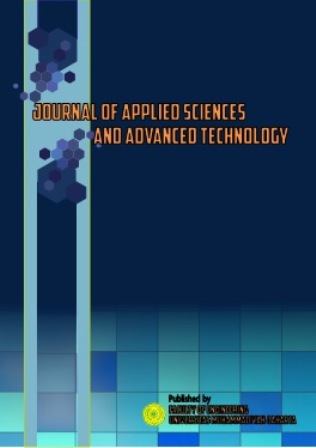Processing of Fibre and Its Application as Liquid Organic fertilizer in Oil Palm (Elaeis guineensis Jacq.) Seedling for Sustainable Agriculture
DOI:
https://doi.org/10.24853/jasat.1.3.81-90Keywords:
Liquid biofertilizer, Mesocarp, Nursery, Oil PalmAbstract
Liquid organic fertilizer has been developed to reduce the dependence of cultivated plants on inorganic fertilizers. based Oil palm fruit fiber, as a by-product of processing palm oil mills, potentially used as organic fertilizers. The purpose of this study was to obtain liquid organic fertilizer from fermented oil palm fruit fiber and analyze the effect of the fertilizer on the growth of oil palm seedlings. Two stages of the research were conducted. The first stage was processing the fibre into liquid organic fertilizer by chopping the oil palm fruit fiber and adding local microorganisms as activators. The fermentation process was carried out for 7 days. The second stage was applying fermented organic fertilizer (POC) to the oil palm growing media. The Completely Randomized Design Method was applied with 5 treatments, namely: P0 (subsoil with no fertilizer), P1 (soil + NPK), P2 (soil + 20 ml POC), P3 (subsoil + 40 ml POC), P4 (subsoil + 60 ml POC). The POC was applied once every week for 16 weeks. The results showed that liquid organic fertilizer had a significant effect on the height of palm seedlings at 4 MAP at 20 ml per seed. The oil palm seed growth tend to increase in several parameters observing in plant diameter, plant biomass and leaves greeness. Liquid organic fertilizer obtained from oil palm fruit fiber can be applied as alternative fertilizer in the prenursery. Further research related to the optimization of process producing liquid organic fertilizer and its application to other cultivated plants is highly recommended.Downloads
References
Parman S. 2007. Pengaruh Pertumbuhan Pupuk Organic Cair Terhadap Pertumbuhan Tanaman Kentang (Solanum tuberosum L). Semarang (ID): Laboratorium Biologi Struktur Dan Fungsi Tumbuhan Jurusan Biologi Fakultas FMIPA UNDIP.
Adnan IS, B Utoyo, A Kusumastuti. 2015. Pengaruh Pupuk NPK dan Pupuk Organik Terhadap Pertumbuhan Bibit Kelapa Sawit (Elaeis guineensis Jacq.) di Main Nursery. Jurnal AIP. 3(2):69-81
Lau K.Y., (2007) Function constrains network architecture and dynamics: a case study on the yeast cell cycle Boolean network. Phys Rev E Stat Nonlin Soft Matter Phys 75(5-1):051907.
Rosenani AB, R Rovica, PM Cheah, CT Lim. 2016. Growth Performance and Nutrient Uptake of Oil Palm Seedling in Prenursery Stage as Influenced by Oil Palm Waste Compost in Growing Media. International Journal of Agronomy. pp1-9. http://dx.doi.org/10.1155/2016/6930735
Naibaho P.M., 1996. Teknologi pengolahan Kelap Sawit. Medan (ID): Pusat Penelitian Kelapa Sawit.
Lim S.H., UK, Shah M.D., Abd-Aziz. 2009. Physicochemichal Changes in Windrow Co- Composting Process of Oil Palm Mesocarp Fiber and Palm Oil Mill Effluent Anaerobic Sludge. Australian Journal of Basic and Applied Sciences, 3(3):2809-2816.
Pauliz B.H., 2009. Pemanfaatan limbah tandan kosong kelapa sawit sebagai teh kompos. pada tanaman selada. Buletin Ilmiah Instiper 16 (1): 6 –14.
Ohorella Z. 2012. Pengaruh dosis pupuk organik cair (POC) kotoran sapi terhadap pertumbuhan dan produksi tanaman sawi hijau (Brassica sinensis L.). Jurnal Agroforestri 7(1): 43-49.
Ji R, G. Dong, W Shi, J Min. 2017. Effect of Liquid Organic Fertilizer on Plant Growth and Rhizosphere Soil Characteristics of Chrysantemum. Sustainability. 9:841 pp 1-16.
Muharam, Jannah A., Rahayu Y.S. 2011. Upaya-Upaya Peningkatan Hasil Tanaman Padi (Oryza sativa L.) Varietas Inpari 1 Melalui Penggunaan Kombinasi Pupuk Hayati, Bahan Organik, dan Pupuk Anorganik. Solusi 9(19).
Poewowidodo. 1992. Telah Kesuburan Tanah.Penerbit Angkasa. Bandung (ID).
Ariyanti M, Intan RD, Yditha M, Yudha AC. 2018. Pertumbuhan Bibit Kelapa Sawit (Elaeis guineensis Jacq.) Dengan Komposisi Media Tanam dan Interval Penyiraman Yang Berbeda. J. Pen. Kelapa Sawit. 26(1):11.22
Lakitan B., 2008. Dasar-Dasar FisiologiTumbuhan. Raja grafindo Persada,Jakarta
Azizah F, A Sulistyo, Subagiya. 2018. Pertumbuhan dan Hasil Ubi Jalar Dengan Pemberian Pupuk Kandang serta Uji Varietas Terhadap Cylas formicarius. Agrotech Res J. 2(1):22-27.
Hasanah F N dan Setiari N. 2007. Pembentukan Akar Pada Stek Batang Nilam (Pogostemon calin Benth.) Setelah direndam IBA (Indol Butyric Acid) Pada Konsentrasi Berbeda. Buletin Anatomi dan Fisiologi Vol. 15 No.2. Jurusan Biologi. Universitas Padjajaran. Bandung (ID).
Nurbaiti, Arnis Y, Jujung S. 2012. Respons Pertumbuhan Bibit Kelapa Sawit (Elaeis guineensis Jacq.) Pada Medium Gambut Dengan Berbagai Periode Penggenangan. J. Agrotek. Trop. 1(1):14-17
Lubis, S.E., Sampoerno.dan Amrul M., 2014. Uji Beberapa Dosis Asap Cair Tandan Kosong Kelapa Sawit pada Bibit Kelapa Sawit (Elaeis guineensis Jacq.). Jom Faperta 1(2).
Handayani S., Al Ikshsan A;, M. Amrul K. 2014. Pertumbuhan Tanaman Kelapa Sawit (Elaeis guineensis Jacq.) Pada Media Campuran Gambut dengan Effluent di Pembibitan Utama. Jom Faperta (1):2.
Martinez-Alcantara B, MR Marinez-Cuenca, A Bermejo, F Legaz, A Quinones. 2016. Liquid Organic Fertilizers for Sustainable Agriculture: Nutrient Uptake of Organic versus Mineral Fertilizers in Citrus Trees. PloS ONE. 11(10):1-20.
Gardner F.P., Pearce R.B., and Mitchell R.L., 1991. Physiology of Crop Plants. Diterjemahkan oleh H.Susilo. Universitas Indonesia Press. Jakarta (ID)
Lee J. 2010. Effect of Application Methods of Organic Fertilizer on Growth, Soil Chemical Properties and Microbial Densities in Organic Bulb Onion Production. Scientia Horticulturae. 124(3):299-305
Febrianna M, S Prijono, N Kusumarini. 2018. Pemanfaatan Pupuk Organik Cair Untuk Meningkatkan Serapan Nitrogen Serta Pertumbuhan dan Produksi Sawi (Brassica juncea L.) Pada Tanah Berpasir. Jurnal Tanah dan Sumberdaya Lahan. 5(2):1009-1018.
Suharno, I. Mawardi, N. Setiabudi, S. Lunga, Tjitrosemito. 2007. Efisiensi penggunaan nitrogen pada tipe vegetasi yang berbeda di Taman Nasional Gunung Halimun Jawa Barat. Biodiversitas. 8:287-294
Downloads
Published
Issue
Section
License
COPYRIGHT POLICY
The author(s) of an article published in the Journal of Applied Sciences and Advanced Technology (JASAT) retains ownership of the intellectual property rights in work (s).
PUBLISHING RIGHTS
The author(s) of an article published in the Journal of Applied Sciences and Advanced Technology (JASAT) have unrestricted publication rights. The authors give the Journal of Applied Sciences and Advanced Technology (JASAT) the right to publish the article and designate the Faculty of Engineering Universitas Muhammadiyah Jakarta Publishing as the original publisher of the article.
LICENSING POLICY
JASAT is an open-access journal that follows the Creative Commons Non-Commercial 4.0 International License (CC BY-NC 4.0), which states that:

Under this license, the reusers must give appropriate credit, provide a link to the license, and indicate if changes were made. Users may do so in any reasonable manner, but not in any way that suggests the licensor endorses users or their use.
Please take the time to read the whole license agreement (https://creativecommons.org/licenses/by-nc/4.0/). As long as reusers follow the license conditions, the owner cannot withdraw these freedoms. The following components are included under this license:
 Attribution: Users must provide appropriate attribution, including a link to the license, and indicate whether or not they made any modifications. Users are free to do so reasonably, but not in a manner that indicates the licensee approves of their usage.
Attribution: Users must provide appropriate attribution, including a link to the license, and indicate whether or not they made any modifications. Users are free to do so reasonably, but not in a manner that indicates the licensee approves of their usage.
 NonCommercial: Users may not use the material for commercial purposes.
NonCommercial: Users may not use the material for commercial purposes.












_2.png)


1.png)

2.png)
